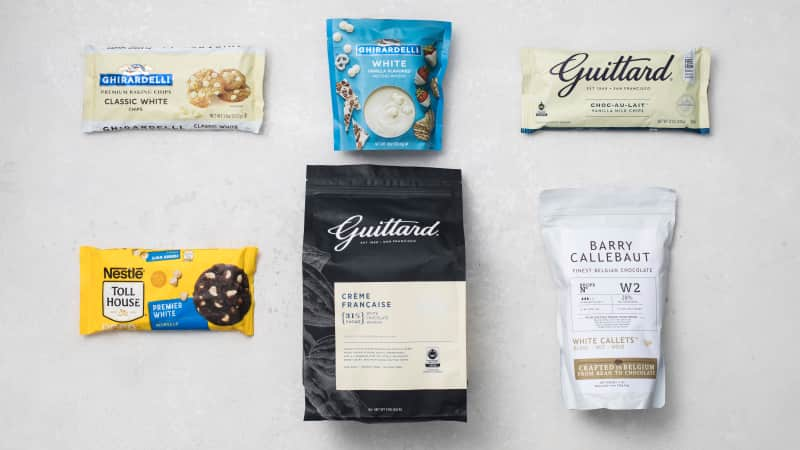The Best Dark Chocolate Chips
Taste Test
With so many products and so many different names, shopping for white chocolate can be confusing. We sampled six to find a versatile winner.
Published Sept. 20, 2019. Appears in America's Test Kitchen TV Season 22: Pork Chops and Blondies

In the test kitchen, we love white chocolate chips for the pops of creamy sweetness they bring to cookies, brownies, and bars. We also like melting them into mousse, bark, frosting, and even fruit tart filling. But since they’re sold under many different names, from white chocolate chips to white chips to baking wafers to white morsels, considering all the options can make your head spin. If a recipe calls for white chocolate chips, does it matter which product you buy?
First, let’s clarify what white chocolate really is. Like all chocolate, it begins with cacao pods. After the cacao beans are harvested from the pods, they are fermented, dried, cleaned, and roasted. Next, the shells are removed from the beans, revealing cacao nibs, which are ground into a paste called chocolate liquor. This liquor is divided into two parts: cocoa butter and cocoa solids. Cocoa butter is responsible for the richness we associate with chocolate. Though cocoa butter has some chocolaty flavor and aroma, cocoa solids are responsible for most of chocolate’s flavor as well as its color and aroma. White chocolate, unlike other types of chocolate, contains only cocoa butter. That’s why it’s so light in color.
According to the U.S. Food and Drug Administration (FDA), white chocolate must have at least 20 percent cocoa butter (in addition to meeting certain requirements for milk solids, milk fat, and sweeteners). Many products replace some—or all—of that cocoa butter with refined fats: palm kernel oil, palm oil, or a combination of the two. These products can’t legally be called white chocolate. Instead, they’re labeled white baking wafers, white morsels, or white melting chips. (For simplicity, we’ve chosen to refer to all these products as “white chips.”)
We gathered six nationally available products, four imitation and two real, priced from about $0.25 to about $1.10 per ounce. We tasted them plain and in Wintermint Bark (without the peppermint topping, which we found distracting), to find the best product for a variety of recipes.
Our tasters picked up on flavor differences among the products. Like good dark and milk chocolates, the real white chocolate samples were described as complex, with most tasters enjoying their milky, nutty, and vanilla flavors. Others called out sour or citrusy notes that they found off-putting. Responses to the white chips were much more uniform. For the most part, these products offered mild yet pleasant hints of vanilla, caramel, and butterscotch and were moderately sweet (one was very sweet). To our surprise, all the white chips...
The mission of America’s Test Kitchen Reviews is to find the best equipment and ingredients for the home cook through rigorous, hands-on testing.

Carolyn is a senior editor for ATK Reviews. She's a French-trained professional baker.

This is a members' feature.